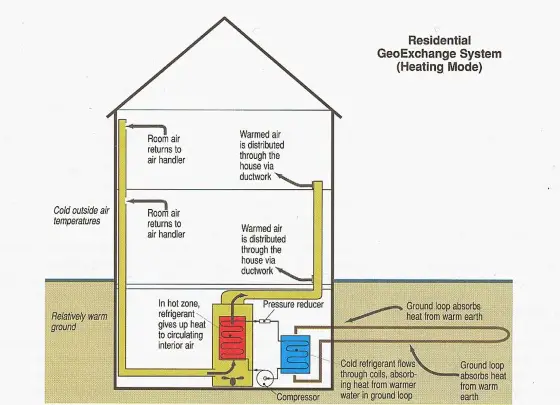Geothermal Energy

Your heating and cooling system loves outdoor conditions where the air temperature is in the 50 - 55F range. Imagine if your HVAC system had access to these temperatures 24 / 7? It can if you bury a large plastic loop in the ground and this loop is filled with a liquid that then connects to your HVAC system!
DEAR TIM: I am looking for an environmentally friendly heating and cooling system for my home. My fuel choices are limited and it appears I have to use a heat pump to achieve my goal. Are there other options out there? I have heard that you can use heat from the soil around you house. Is this true and if so, how is it done? Veronica T., Tifton, GA
DEAR VERONICA: You are right on target. If you combine the technology of heat pumps with the nearly constant temperature of the soil under your lot, you can save money and help preserve resources for our future generations. In my opinion you are a perfect candidate for the expanding use and acceptance of geothermal heat pumps. What's more, the Environmental Protection Agency and the Department of Energy are currently promoting this technology through their Earth Comfort Program.
Geothermal heat pumps transfer heat to and from the soil under your lot. Conventional heat pumps do the exact same thing except they transfer the heat to and from outside air. If you decide that a geo-thermal system makes sense for you, there will be no unsightly and noisy outdoor equipment.
Geothermal systems are quiet and compact. Often all of the equipment fits into one metal cabinet. When operating in the heat mode, the temperature of the air floating from the ducts is around 110 F. This is much more comfortable than the "cool" air that tends to waft from traditional heat pumps.
One type of geothermal system extracts or sends heat to the soil via a buried loop of durable plastic tubing. The tubing contains a liquid similar to automobile anti-freeze. Because soil temperatures below the level that frost penetrates often are constant through the year, it is not uncommon to find soil temperatures near 55 F in most parts of the USA. This is very nearly the perfect temperature at which heat pump technology will operate at maximum efficiency.
When you need heat in your home the solution inside the closed loop delivers heat from the soil to the indoor unit. The heat is extracted from the closed loop solution. Once the loop solution gives up all of its heat, it is pumped through the loop. The chilled solution begins to get warm again as it travels back towards the house. When you need air conditioning in your home the exact same process happens, only backwards. The heat transfer is extremely efficient. During the heating season you might experience savings of 40 to 70 percent and savings of 30 to 60 percent while using your air conditioner. Dense clay soils work best for geothermal heating and cooling systems. Dry, sandy soils transfer heat poorly. Wet, sandy soils are superb!
The buried loop in the soil can be done one of two ways. Relatively shallow horizontal loops can be used on larger lots with greater surface area. Vertical tubes are drilled for small lots. If you have a medium or large pond on your property that does not freeze solid in the winter you are really in luck. You can simply place the plastic tubing loop in the bottom of the pond for maximum heat transfer possibilities. Some people adjacent to large underground water sources can tap this resource and use it to heat and cool their homes.
The geothermal mechanical equipment used to heat and cool your home costs virtually the same as conventional heat pumps. You will experience added costs when you install the underground plastic loop piping. The current average cost is about $900 per ton of cooling load. This works out to about an up-charge of $3,150 (3.5 tons of cooling) for the average home.
Because of the deregulation of the electric utility industry many utility companies are offering rebates or other incentives to homeowners who choose to use geothermal heating and cooling systems. Existing homes as well as new ones can adapt to this eco-friendly technology. New technology is being developed that allows the loop piping to be installed with minimal disturbance to existing lawns and landscaping.
Author's Notes:
November, 2003
Geothermal systems work best in moderate climates. For example, those who live in the boundary between the South and the Midwest can really extract savings from the soil. People who can place the loops in a large pond or lake can also achieve maximum benefits. The soil type, depth of winter frost penetration and assorted other factors will determine how much money a geothermal system will save for you over the long haul.
Tim Carter
Column 262
One Response to Geothermal Energy